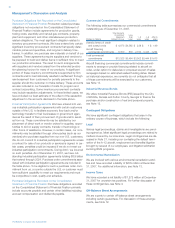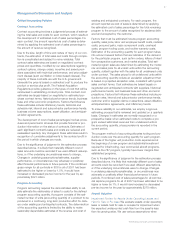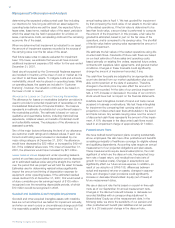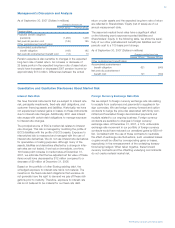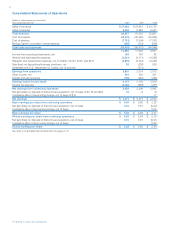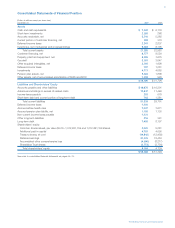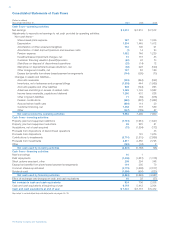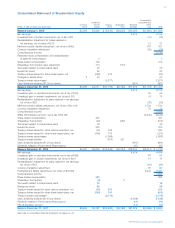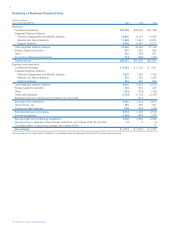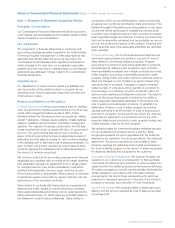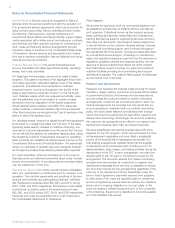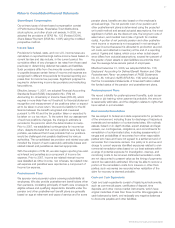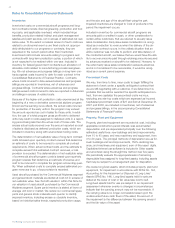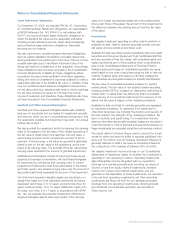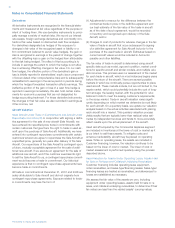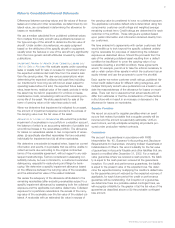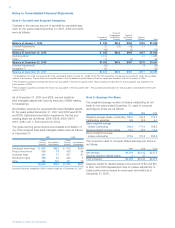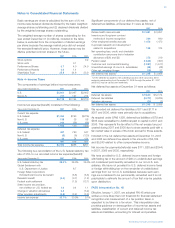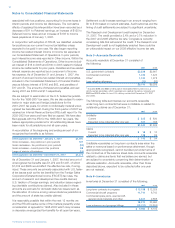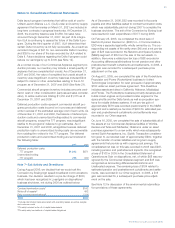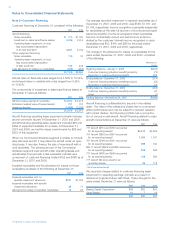Boeing 2007 Annual Report Download - page 49
Download and view the complete annual report
Please find page 49 of the 2007 Boeing annual report below. You can navigate through the pages in the report by either clicking on the pages listed below, or by using the keyword search tool below to find specific information within the annual report.46
Notes to Consolidated Financial Statements
Service Revenue Service revenue is recognized in Sales of
services when the service is performed with the exception of
U.S. government service agreements, which are accounted for
using contract accounting. Service activities primarily include
the following: Delta launches, ongoing maintenance of
International Space Station and Space Shuttle, support agree-
ments associated with military aircraft and helicopter contracts,
and technical and flight operation services for commercial air-
craft. Lease and financing revenue arrangements are also
included in Sales of services on the Consolidated Statements
of Operations. Service revenue and associated cost of sales
from pay-in-advance subscription fees are deferred and recog-
nized as services are rendered.
Financial Services Revenue We record financial services
revenue associated with sales-type finance leases, operating
leases, and notes receivable.
For sales-type finance leases, we record an asset at lease
inception. This asset is recorded at the aggregate future mini-
mum lease payments, estimated residual value of the leased
equipment, and deferred incremental direct costs less
unearned income. Income is recognized over the life of the
lease to approximate a level rate of return on the net invest-
ment. Residual values, which are reviewed periodically, repre-
sent the estimated amount we expect to receive at lease
termination from the disposition of the leased equipment.
Actual residual values realized could differ from these esti-
mates. Declines in estimated residual value that are deemed
other than temporary are recognized as Cost of services in the
period in which the declines occur.
For operating leases, revenue on leased aircraft and equipment
is recorded on a straight-line basis over the term of the lease.
Operating lease assets, included in Customer financing, are
recorded at cost and depreciated over the period that we proj-
ect we will hold the asset to an estimated residual value, using
the straight-line method. Prepayments received on operating
lease contracts are classified as Deferred lease income on the
Consolidated Statements of Financial Position. We periodically
review our estimates of residual value and recognize forecast-
ed changes by prospectively adjusting depreciation expense.
For notes receivable, notes are recorded net of any unamor-
tized discounts and deferred incremental direct costs. Interest
income and amortization of any discounts are recorded ratably
over the related term of the note.
Reinsurance Revenue Our wholly-owned insurance subsidiary,
Astro Ltd., participates in a reinsurance pool for workers’ com-
pensation. The member agreements and practices of the rein-
surance pool minimize any participating members’ individual
risk. Reinsurance revenues were $84, $84, and $101 during
2007, 2006, and 2005 respectively. Reinsurance costs related
to premiums and claims paid to the reinsurance pool were
$93, $91, and $115 during 2007, 2006, and 2005 respectively.
Revenues and costs are presented net in Cost of services in
the Consolidated Statements of Operations.
Fleet Support
We provide the operators of all our commercial airplane mod-
els assistance and services to facilitate efficient and safe air-
craft operation. Collectively known as fleet support services,
these activities and services include flight and maintenance
training, field service support, engineering services, and tech-
nical data and documents. Fleet support activity begins prior
to aircraft delivery as the customer receives training, manuals,
and technical consulting support, and continues throughout
the operational life of the aircraft. Services provided after deliv-
ery include field service support, consulting on maintenance,
repair, and operational issues brought forth by the customer or
regulators, updating manuals and engineering data, and the
issuance of service bulletins that impact the entire model’s
fleet. Field service support involves our personnel located at
customer facilities providing and coordinating fleet support
activities and requests. The costs for fleet support are expensed
as incurred as Cost of services.
Research and Development
Research and development includes costs incurred for experi-
mentation, design, testing, and bid and proposal efforts related
to government products and services and are expensed as
incurred unless the costs are related to certain contractual
arrangements. Costs that are incurred pursuant to such con-
tractual arrangements are recorded over the period that rev-
enue is recognized, consistent with our contract accounting
policy. We have certain research and development arrange-
ments that meet the requirement for best efforts research and
development accounting. Accordingly, the amounts funded by
the customer are recognized as an offset to our research and
development expense rather than as contract revenues.
We have established cost sharing arrangements with some
suppliers for the 787 program, which have enhanced our inter-
nal development capabilities and have offset a substantial
portion of the financial risk of developing this aircraft. Our
cost sharing arrangements explicitly state that the supplier
contributions are for reimbursements of costs we incur for
experimentation, basic design, and testing activities during the
development of the 787. In each arrangement, we retain sub-
stantial rights to the 787 part or component covered by the
arrangement. The amounts received from these cost sharing
arrangements are recorded as a reduction to research and
development expenses since we have no obligation to refund
any amounts received per the arrangements regardless of the
outcome of the development efforts. Specifically, under the
terms of each agreement, payments received from suppliers
for their share of the costs are typically based on milestones
and are recognized as earned when we achieve the milestone
events and no ongoing obligation on our part exists. In the
event we receive a milestone payment prior to the completion
of the milestone, the amount is classified in Accounts payable
and other liabilities until earned.
The Boeing Company and Subsidiaries


